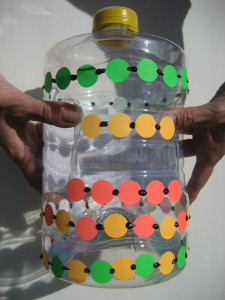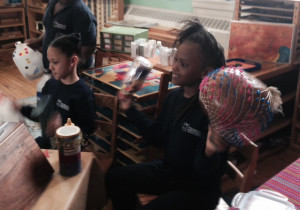 Do you know the three R’s? Reduce, Reuse and Recycle.
Do you know the three R’s? Reduce, Reuse and Recycle.
How about the four “R’s”? Reduce, Reuse, Recycle… and Rock Out! While you’re going greener and thinking about reducing or reusing plastic, here’s a fun way to turn large containers into child-size versions of African shekeres.
What’s a Shekere?
I wonder if shekeres were “original recycling projects”. Perhaps someone looked at dried gourds and decided they could be made into musical instruments. To do 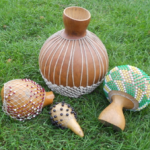 this, a netting of beads (called a skirt) was crafted around the gourd and small beads, seeds or shells were strung in the fiber to create the sound of the instrument. Most music historians believe the shekere began in West Africa but can now be found with variations in size, beadwork, shape and manner of playing throughout the African continent and around the world.
this, a netting of beads (called a skirt) was crafted around the gourd and small beads, seeds or shells were strung in the fiber to create the sound of the instrument. Most music historians believe the shekere began in West Africa but can now be found with variations in size, beadwork, shape and manner of playing throughout the African continent and around the world.
A Milk Jug Shekere
Since you probably have more plastic containers than cleaned and dried gourds, start by finding an empty milk jug, large water bottle or similar item from your recycling bin. Before you begin, make sure it fits nicely into your child’s hands.
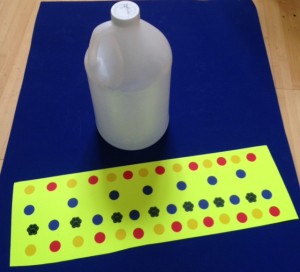 Beading With Stickers or Markers
Beading With Stickers or Markers
Doing intricate crafts like beading is great fun but takes practice and patience, plus motor skills that can be a difficult for small children. Here’s an easy alternative.
If your container is clear and clean, you can place stickers directly onto the plastic bottle or draw “beads” with markers, making colorful patterns or shapes. If there’s a label on the container, you can cut out a piece of poster board or construction paper to fit the container and lay the paper flat. This makes for easy “sticker beading” and a fun way to explore patterns, shapes and colors with your young child.
If you’re working with a classroom of kids or have a limited time to do this project, you can skip the aspect of trying to “bead” the shekere and allow the kids to simply decorate the outside of the container.
Sounding Good!
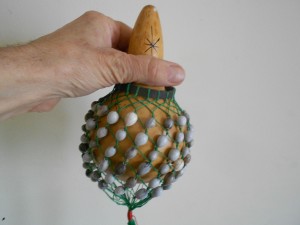 In traditional shekeres, the sound comes from the beads or seeds rattling on the outside of the gourd. In our recycled version, we’ll need to add something inside the container to create the sound. Here are some suggestions for a quieter recycled shekere: sand, salt, sugar, tiny pasta (like acini de pepi), seed beads, Q-tips and paper clips. Here are some fillings you can use to create a louder instrument: pebbles, dried pasta, dried beans, popcorn kernels, marbles or pennies.
In traditional shekeres, the sound comes from the beads or seeds rattling on the outside of the gourd. In our recycled version, we’ll need to add something inside the container to create the sound. Here are some suggestions for a quieter recycled shekere: sand, salt, sugar, tiny pasta (like acini de pepi), seed beads, Q-tips and paper clips. Here are some fillings you can use to create a louder instrument: pebbles, dried pasta, dried beans, popcorn kernels, marbles or pennies.
Once you’ve filled your shekere and you like the sound it makes. Put the cap on and seal it into place with heavy duty tape to keep this project child-safe.
Although a shekere is a rattle, there’s a lot of different ways you can play it. Here are some playing suggestions:
Hold the handle and shake.
Hold both sides and rattle the contents back and forth.
Hold both sides and toss it gently while twisting it.
Hold it vertically and toss it gently from hand to hand.
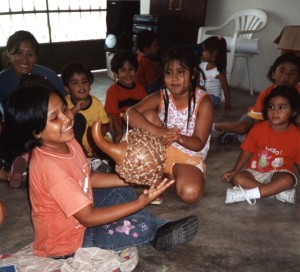 Sit a short distance from a friend and toss it back and forth.
Sit a short distance from a friend and toss it back and forth.
With a group of children, sit in a circle and toss it from child to child around the circle.
Try any of the above ideas while singing or while music is playing. Try to shake along to the beat.
Links and Resources
Hear A Shekere
http://www.dariamusic.com/shekere.php
Color a Shekere Online
http://www.dariamusic.com/color_Shekere.php
Bead an African Shekere
https://makingmulticulturalmusic.wordpress.com/2013/12/04/bead-your-own-african-shekere/
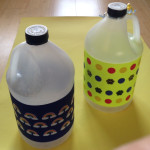 Make a Classroom Shekere (From A Gourd)
Make a Classroom Shekere (From A Gourd)
http://tinytappingtoes.wordpress.com/2013/08/05/easy-gourd-shekere-for-a-child-or-a-classroom/
An Alphabet Shekere Game
http://www.trueaimeducation.com/2012/10/guest-post-learning-letters-with-an-alphabet-shekere.html
Sekere.com – Beaded Sekeres from Master Craftswoman, Sara Fabunmi
Cultural Value of the Shekere, Article By Sara Fabunmi
https://makingmulticulturalmusic.wordpress.com/2011/10/25/the-cultural-value-of-the-sekere/

